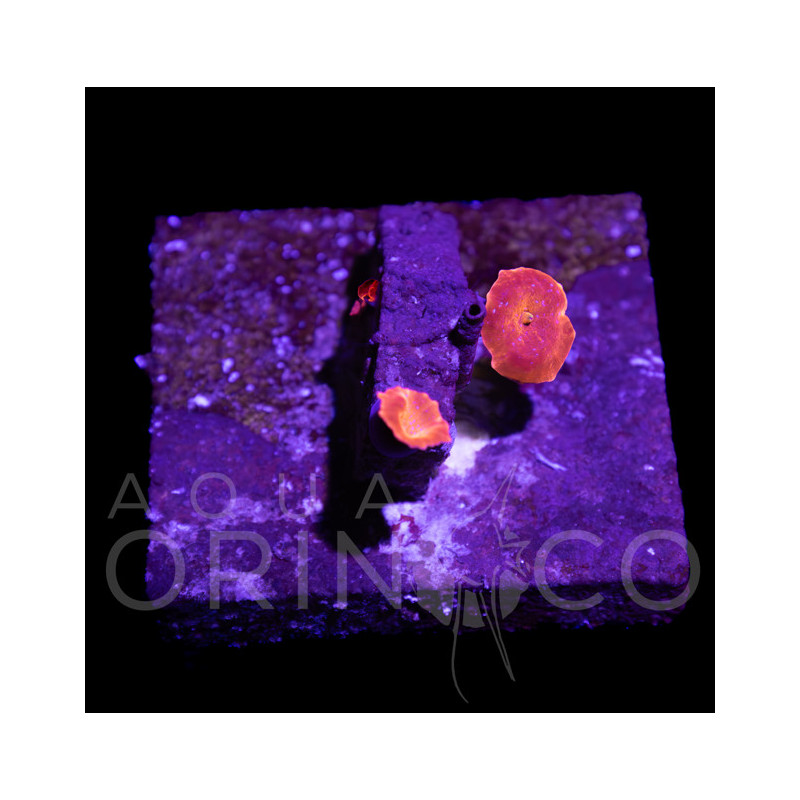More info
Unique piece - "WYSIWYG"!
What You See Is What You Get
Discosoma sp.
When people first get into the reef aquarium hobby they often ask us about hardier corals that are good for beginners, and my first suggestion is usually mushrooms from the genus Discosoma, despite the fact that they are corallimorphs and not corals.
There’s three main reasons that make these mushrooms such a good option. First, the Discosoma are one of the most resilient of the corallimorphs. They can thrive in a wide variety of tanks, and are known to put up with some neglect that is sometimes observed by those who are newer to the reef hobby and don’t exactly know what they’re getting themselves into. I often joke that if your Discosoma are dying, you really need to find a new hobby, because this reef aquarium thing probably isn’t going to work out if you can’t keep these practically indestructible forces alive.
The second reason Discosoma are so great is that they come in every color imaginable as well as a variety of patterns. There are some that are striped, spotted, and even some with irregular splotches, but the most striking ones are usually the ones that are just a solid color. So if you are a beginner that is setting up a tank for the first time, you’re going to have a Discosoma for any aesthetic you would want to achieve.
The third reason these mushrooms are a great option for any new aquarist, is they can be propagated really easily. These mushrooms will also naturally divide by a process called pedal laceration. This is where, the mushroom will slowly walk around and leave pieces of its foot behind and those pieces will grow into new mushrooms. To see how we propagate Discosoma here, check out our video that goes more in-depth on the topic.
Despite these mushrooms being pretty tolerable of any situation they are put in, we have found that there are more favorable conditions, and we are going to dive into that right now starting with lighting.
Lighting
Even though I usually recommend low light for Discosoma, I would also recommend playing around with medium light. It’s possible that brighter light can lead to brighter coloration of the polyps. Just remember when increasing light, do it gradually. Severe over exposure will always be more dangerous than severe under exposure due to oxide radicals that form on the flesh of the mushrooms that look like strange white growths. This is a result from over exposure that you’re definitely going to want to avoid.

Low Light |
Low light translates to about 30-50 PAR |

Medium Light |
Medium Light is between 50-150 PAR |
|
High Light |
High Light is anything over 150 PAR |
Water Flow
As for flow, you’re going to want to keep it really really low, no exceptions, end of story. There is two main reasons for this.
The first reason is, one of the few ways that mushrooms meet an early demise is if they detach from the substrate they were holding on to and drift around the tank. For whatever reason, Discosoma are not great at reattaching themselves to anything and too much flow will make it almost impossible for them to do so.
The second reason is that they extend out more in areas of low flow. So in general, lower flow means a happier coral.
Feeding
Still on the topic of flow, a lower flow will also make it a lot easier for Discosoma to feed. Almost no one feeds Discosoma, but we found that they can be fed smaller foods directly if the water flow in the tank remains pretty low.

I have not found them to be particularly picky when it comes to the types of food they will eat. Even if you don’t wish to feed them, adding amino acids to your tank will still be beneficial for their overall health.
Amino Acids are simple organic compounds that play a major role in building proteins as well as other biological functions at the cellular level. There are a little over 20 different types of amino acids. Most of them can be synthesized by the organism but some cannot be and must be taken in by feeding. Those amino acids are termed essential amino acids and they vary from species to species. Corals regularly take in available amino acids from the water column so it is easy to provide them with adequate quantities by broadcast feeding an amino acid solution. They are available from any number of commercially available reef supplement manufacturers. This may be the easiest way to feed your corals because as long as amino acids are bioavailable in the water column, the corals will soak them up.
Location
Discosoma mushrooms are found all over the Indo-pacific region in places such as Fiji, Tonga, and the Soloman Islands. They’re also found near Australia in the Great Barrier Reef

